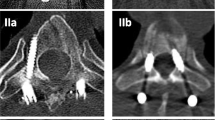Abstract
Purpose
To assess the pedicle morphology in the lower thoracic and lumbar spine in an Indian population and to determine the causes of pedicle wall violation by pedicle screws.
Methods
Computerised tomographic scans of 135 consecutive patients with thoracolumbar and lumbar spine fractures were prospectively analysed to determine the pedicle morphology. The transverse pedicle angle, pedicle diameter and screw path length at 527 uninjured levels were measured. Post-operative CT scans of 117 patients were analysed to determine the accuracy of 468 pedicle screws at 234 vertebrae.
Results
The lowest (mean ± SD) transverse pedicle width in the lower thoracic spine was 5.4 ± 0.70 mm, whereas in the lumbar spine it was 7.2 ± 0.87 mm. The shortest (mean ± SD) screw path length in lower thoracic pedicles was 35.8 ± 2.10 and 41.9 ± 2.18 mm in the lumbar spine. The mean transverse pedicle angle in the lower thoracic spine was consistently less than 5°, whereas it gradually increased from L1 through L5 from 8.5° to 30°. Forty-one screws violated the pedicle wall, due to erroneous angle of screw insertion.
Conclusions
In the current study, pedicle dimensions were smaller compared to the Western population. In Indian patients, pedicle screws of 5 mm diameter and 30 mm length, and 6 mm diameter and 35 mm length can safely be used in the lower thoracic and lumbar spine, respectively. However, it is important to assess the pedicle morphology on imaging prior to pedicle fixation.




Similar content being viewed by others
References
Roy-Camille R, Saillant G, Berteaux D, Salgado V (1976) Osteosynthesis of thoraco-lumbar spine fractures with metal plates screwed through the vertebral pedicles. Reconstr Surg Traumatol 15:2–16
Zindrick MR, Wiltse LL, Doormik A, Widell EH, Knight GW, Patwardhan SG, Thomas JC (1987) Analysis of the morphometric characteristics of the thoracic and lumbar pedicles. Spine 12:160–165
Krag MH (1990) Biomechanics of thoracolumbar spinal fixation. Spine 16:584–599
Berry JL, Moran JM, Berg WS, Steffee AD (1987) A morphometric study of human lumbar and selected thoracic vertebrae. Spine 12:362–367
Olsewski JN, Simmons EH, Kallen FC, Mendel FC, Severin CM, Berens DL (1990) Morphometry of the lumbar spine: anatomical perspectives related to transpedicular fixation. J Bone Joint Surg Am 72:541–549
Hou S, Hu R, Shi Y (1993) Pedicle morphology of the lower thoracic and lumbar spine in a Chinese population. Spine 13:1850–1855
Kim NH, Lee HM, Chung IH, Kim HJ, Kim SJ (1994) Morphometric study of the pedicles of thoracic and lumbar vertebrae in Koreans. Spine 12:1390–1394
Mitra SR, Datir SP (2004) Morphometric study of the thoracic vertebral pedicle in an Indian population. Spine 11:1174–1181
Mitra SR, Datir SP, Jadhav S (2002) Morphometric study of the lumbar pedicle in the Indian population as related to pedicular screw fixation. Spine 27(5):453–459
Kaur K, Singh R, Prasath V, Magu S, Tanwar M (2016) Computed tomographic-based morphometric study of thoracic spine and its relevance to anaesthetic and spinal surgical procedures. J Clin Orthop Trauma 2:101–108
Hassan E, Liau KM, Ariffin I, Yusof AH (2010) Internal morphometry of thoracic pedicles in the immature spine. Spine 13:1253–1256
Mohanty SP, Bhat SN, Kanhangad MP, Gosal GS (2017) Pedicle screw fixation in thoracolumbar and lumbar spine assisted by lateral fluoroscopic imaging: a study to evaluate the accuracy of screw placement. Musculoskeletal Surg 11:1–9
Simpson V, Clair B, Ordway NR, Albanese SA, Lavelle WF (2016) Are traditional radiographic methods accurate predictors of pedicle morphology? Spine 22:1740–1746
Gertzbein SD, Robbins SE (1990) Accuracy of pedicular screw placement in vivo. Spine 15:11–14
Vaccaro AR, Rizzolo SJ, Allardyce TJ et al (1995) Placement of pedicle screws in the thoracic spine: morphometric analysis of the thoracic vertebrae. J Bone Joint Surg Am 77:1193–1199
Varghese V, Kumar GS, Krishnan V (2017) Effect of various factors on pull out strength of pedicle screw in normal and osteoporotic cancellous bone models. Med Eng Phys 40:28–38
Matsukawa K, Yato Y, Imabayashi H et al (2016) Biomechanical evaluation of fixation strength among different sizes of pedicle screws using the cortical bone trajectory: What is the ideal screw size for optimal fixation? Acta Neurochir 158(3):465–471
Goel VK, Gilbertson LG (1997) Basic science and spinal instrumentation. Clin Orthop Relat Res 335:10–31
Castro WH, Halm H, Jerosch J, Malms J, Steinbeck J, Blasius S (1996) Accuracy of pedicle screw placement in lumbar vertebrae. Spine 21:1320–1324
Weinstein JN, Spratt KF, Spengler D, Brick C (1998) Spinal pedicle fixation: reality and validity of roentgenogram—based assessment and surgical factors on successful screw placement. Spine 13:1012–1016
Zhang Y-Y, Liu P-Y, Lu Y, Davies KM, Dvornyk V, Recker RR, Deng H-W (2005) Race and sex differences and contribution of height: a study on bone size in healthy Caucasians and Chinese. Am J Hum Biol 17:568–575
Author information
Authors and Affiliations
Corresponding author
Ethics declarations
Conflict of interest
The authors declare that they have no conflict of interest.
Ethical approval
All procedures performed in studies involving human participants were in accordance with the ethical standards of the institutional and/or national research committee and with the 1964 Declaration of Helsinki and its later amendments or comparable ethical standards. Institutional ethical clearance was obtained before starting the study.
Informed consent
Informed consent was obtained from all individual participants included in the study.
Human and animal rights
This article does not contain any studies with animals performed by any of the authors.
Rights and permissions
About this article
Cite this article
Mohanty, S.P., Pai Kanhangad, M., Bhat, S.N. et al. Morphometry of the lower thoracic and lumbar pedicles and its relevance in pedicle fixation. Musculoskelet Surg 102, 299–305 (2018). https://doi.org/10.1007/s12306-018-0534-z
Received:
Accepted:
Published:
Issue Date:
DOI: https://doi.org/10.1007/s12306-018-0534-z




